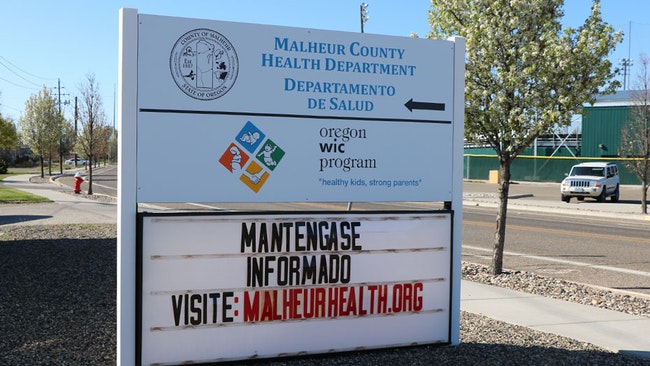
Poverty and a large population with underlying health conditions means some Malheur County residents may be at a higher risk from the COVID-19 virus outbreak.
NOTE: The Enterprise is providing free access to its content related to the coronavirus as a community service. Subscriptions at $5 a month help the Enterprise keep this up.
VALE – Much of Malheur County is overweight, suffering from underlying health conditions and mired in poverty, putting more local people at higher risk if they become infected with the coronavirus.
More than half the county’s residents face underlying health conditions such as asthma, chronic obstructive pulmonary disease, heart disease, cancer, diabetes and obesity, said Sarah Poe, the director of the Malheur County Health Department.
Poe said 2019 data from the state showed 54% of the county’s 20,500 adults – or 10,873 people – have one or more chronic diseases.
“A lot of our community is on medication long term for their chronic disease and spend a lot of time managing their health. This pandemic has amplified all of that across the board,” said Poe.
Poe said underlying health conditions are a “large predictor of more severe cases of COVID.”
“Obesity and diabetes and heart disease are also factor in poor diets. Poor diets are a factor of poverty and underlying health conditions,” said Poe.
Malheur County has the highest poverty rate – 23% – in the state while statistics from the Oregon Hunger Task Force showed 13% of county’s population was food insecure. Food insecure means individuals or families that lack a reliable access to an enough quantity of affordable, nutritious food.
“Families were struggling to provide enough food before (COVID-19). Now it’s a lot harder,” said Poe.
Those dynamics – poverty, obesity, underlying health conditions – mean the county is more vulnerable to a COVID-19 surge.
Other factors, such as teen pregnancy, also play a role in the county’s overall health, said Poe.
“Our teen pregnancy is the highest in the state, more than double the state average. That is as huge piece of this,” said Poe.
Teens who have babies often fall or are already living in poverty, said Poe.
“People who have children when they are teens or young adults who are not financially stable. It can impact their ability to get out poverty. Poverty has a direct correlation to negative health outcomes,” said Poe.
The area’s rural geography also makes the county more vulnerable to COVID-19, said Poe. The area, she said, is “disconnected from enough health care providers and access to resources.”
Poe said a COVID-19 outbreak in Malheur County will look different than one in Multnomah County.
“You look at Portland and it has all these cases, but Portland is ready to take care of them. It has tons of resources. Way more beds. Way more first responders. Here we have amazing people, but we are rural, so it is not that many people to meet the same needs,” said Poe.
The county’s challenges mean the state’s “stay home” mandate is crucial, said Ken Hart, president of Saint Alphonsus Medical Center Ontario.
“One (COVID-19 virus case) here is a lot more than one in an urban area. That’s why it is even more important for us not to get into a sense things are fine. We have done a great job with social distancing, but we need to keep it up because we want to stay as we are,” said Hart.
Poe said social distancing may be even more important in a place like Malheur County where so many struggle with underlying health conditions.
“We need to be very careful to protect people who are vulnerable,” said Poe.
She said the stay home mandate likely will need to be in place through May because the county isn’t close to its peak in COVID-19 virus cases. To date, the county has recorded just five people with the virus and tested 167 people.
Poe is expecting many more infections to emerge.
“Even when you reach your peak, you have to be vey careful about how you reopen,” said Poe.
Poe said widespread testing would be needed to safely allow businesses to fully open and that could happen by June.
Testing, though, is a problem. While lab capacity has opened, there remains a shortage of COVID-19 virus tests.
“We’ve completed 157 tests. That is better than it’s been but that is a very, very low percentage of our population,” said Poe.
The turnaround time on the tests averages four to eight days.
“Testing will be key and testing really, really extensively, hopefully test front line responders and health care workers, get people who have immunity identified and back out there,” said Poe.
Until that day arrives, said Poe, social distancing is the best defense to protect a county that is vulnerable.
Have a news tip? Contact reporter Pat Caldwell at pat@malheurenterprise. com.
HELP THE COMMUNITY GET THE FACTS….
As long as we can, the Malheur Enterprise will provide free access to all stories related to COVID-19. With businesses closed and not advertising, community support for this service is vital. Help one of two ways:
SUBSCRIBE – $5 a month, automatically.
CONTRIBUTE – to our LOCAL NEWS FUND. Tax deductible, and anonymous if you wish.




